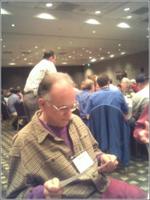After Jonathan Crowe mentioned that ArcReader 9.1 can display true 3D text on ArcGlobe and thus avoid having to acquire ArcGIS to view these maps, which are competitors to Google Earth, I went and checked the system requirements for ArcReader.
Check it out:
Hardware Requirements
CPU Speed:
800 MHz minimum recommended or higher
Processor:
Intel Pentium or Intel Xeon Processors
Memory/RAM:
For viewing 2D map documents:
- 256 MB minimum, 512 MB recommended
For viewing 3D globe documents:
- 512 MB minimum, 1 GB recommended
Disk Space Requirements:
- In addition, up to 50 MB of disk space maybe needed in the Windows System directory (typically C:\Windows\System32). You can view the disk space requirement for each of the 9.1 components in the Setup program.
Notes:
Internet Explorer 6.0 Requirement:
- Some features of ArcReader require a minimum installation of Microsoft Internet Explorer Version 6.0. If you do not have an installation of Microsoft Internet Explorer Version 6.0 or higher, you must obtain and install it prior to installing ArcReader.
- Installation on an NTFS (New Technology File System) drive is strongly recommended.
Additional Requirements with ArcReader:
- CPU Speed: 1.5 GHz recommended or higher.
- ArcReader will create cache files when used, additional disk space may be required for this and any other 3D data used.
- Video Card: An OpenGL 1.1 or above compliant video card is required, with at least 32 MB of video memory, however 64 MB of video memory is recommended.
Printer Support:
ArcReader supports printing to any Microsoft certified Windows printer using the native driver in ArcGIS. Please note that some printer drivers do not support complex maps and the ArcPress printer driver or additional hardware may be needed for these complex maps.
ESRI recommends the following configuration when printing large maps with the ArcPress printer drivers:
- Pagefile system size of 4096 Kb is recommended. ArcPress depends on being able to acquire potentially large contiguous blocks of memory to process a map. The windows limit is 2048 Kb and byhaving a pagefile.sys file of at least twice that size helps ensure that other applications running and using the pagefile system will not introduce an unexpected limit for the ArcPress printer driver.
- Pagefile system should be stored on a dedicated partition or, if possible, a dedicated drive. This will prevent the file from becoming fragmented and diminishing ArcPress’s ability to acquire contiguous blocks of memory.
- If large complex maps do not print, then reboot the computer to ensure the pagefile system is cleared. If the pagefile system is not a dedicated drive or partition, make sure that drive does not need to be defragmented.
- Disk Space: at lease 10 GB of space is free on the drive where %TEMP% is located, as potentially large temporary files will be written there while ArcPress is processing a map for printing
So basically you're telling me I need 1 gig of RAM, 10 gig of disk space, 1.5 gig of chip speed, and oh yes, a "dedicated partition" for printing??
So this kind of power is possessed by what, 0.00001% of the world's population? I have a fairly new laptop, and it has 800mHz chipspeed and half a gig or RAM and I think that's way powerful. Can I run ArcReader? No.





